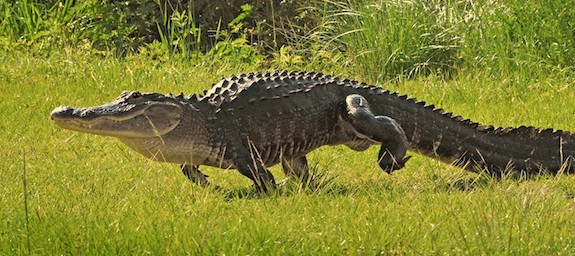
Gator out for a stroll. Courtesy of Flickr user Andrea Westmoreland.
This is the fourth of 12 Things You Should Know about Alligators and Everglades Wildlife, a free eBook.
“If you are ever being chased on land by an alligator, you should run in a zig-zag pattern.” Have you heard that myth before? Actually, the chances of you being chased by an alligator on land are highly unlikely. Alligators don’t really like to run long distances, and although they can travel very quickly in the water, they are typically slower moving on land. However, even with their heavy bodies and slow metabolisms, alligators are capable of short bursts of speed that can exceed 30 miles per hour. This speed is typically seen when an alligator is lunging after prey on the bank of the water, not running across a large area of land.
According to the Florida Fish & Wildlife Conservation Commission, there is really no reason to focus on the ground speed of alligators. Alligators are aquatic animals who hunt and capture prey that is in, or immediately adjacent to, water. Alligators and other crocodilians will go on land to feed on dead animal carcasses. They also may attempt to prey upon confined or tethered animals.
So, although alligators are capable of running, they typically only do this to flee threatening situations. There is no documented evidence of alligators running after human beings or any other land animal to prey upon them. Also, there is no basis to the myth that you should run in zig-zag patterns to avoid a charging alligator. If you do find yourself in the unlikely (and unfortunate) position of avoiding a lunging alligator, you should run in a straight line away from the alligator and its habitat. Regardless of how fast alligators can run, zig-zagging or not, you should never approach an alligator that is on land, nor should you be swimming in water in which an alligator has been spotted.
In other words, don’t put yourself in danger in the first place and you’ll never really need to know how fast gators can run!
